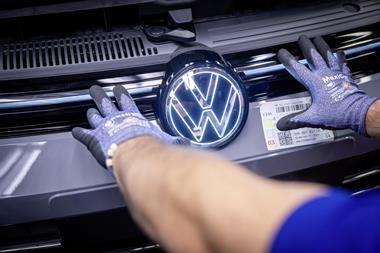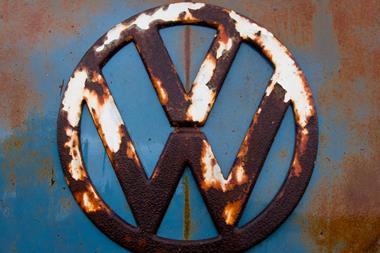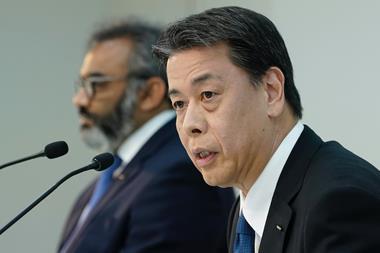OEMs are reassessing their investments in the region amid a slowdown in car, CV and motorcycle sales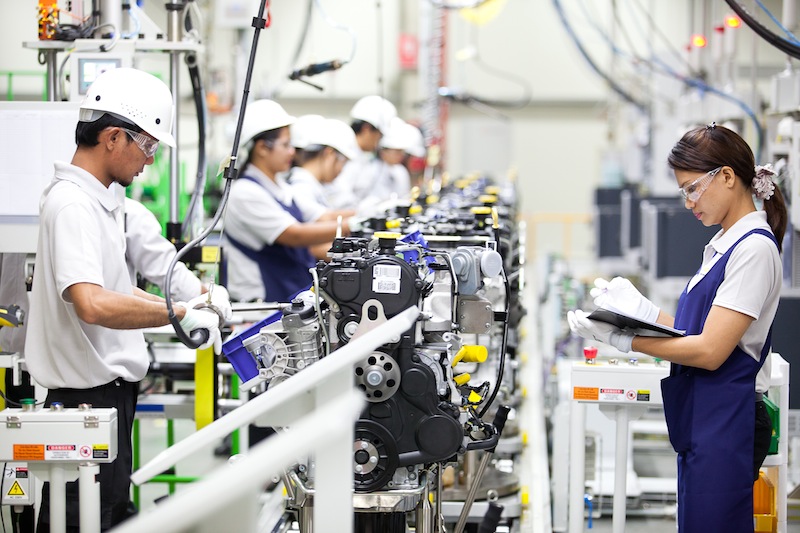
Plummeting vehicle sales in Thailand and Indonesia are hurting manufacturers and causing some to rethink their plans in the region. The countries are the two biggest automotive hubs in South-East Asia and also two of the fastest-growing vehicle manufacturing centres in the world. At the moment, however, a fragile local economic situation is suppressing a key element of their growth – the huge potential to increase domestic car ownership from its current low base.
To the end of April this year, vehicle sales in Thailand fell 26% compared with the same month last year, and 15% in the first four months, according to the Federation of Thai Industries. Heavy-truck sales are also falling in Thailand, last year dropping 47% to 21,000 with no return to growth expected this year. Indonesia too has had a difficult year, with car and commercial vehicle (CV) sales falling by a similar amount: 24% in April and 16% in the first four months, according to figures from the local manufacturers’ association, Gaikindo. That April decline was the biggest fall since the recession in 2009 and was the eighth month in which sales had fallen.
Thailand, however, has one saving grace: exports. The number of vehicles shipped out of the country in the same period increased 14% to just over 410,000, meaning that production of cars and CVs rose very slightly in the first four months to 648,508. That is after production fell by almost a quarter last year to 1.9m on the back of local sales falling 34% to 882,000 (although analyst IHS Automotive believes that Thailand will grow production to 3m by 2020).
By contrast, Indonesia – South-East Asia’s biggest economy and its most populous nation at 250m – does not have Thailand’s export advantage and records more local sales. To the end of March, sales figures for cars and CVs almost matched the number produced within the country, at just under 300,000. This means Indonesia is little able to ‘export itself’ out of its current problems. Last year, the country built 1.3m cars and CVs, a figure that IHS believes will rise to 1.7m by 2020.

Slow growth in Indonesia has created one casualty in the form of GM, which in March this year said it would cease production at its Bekasi plant, Jakarta, by the end of June. The OEM had only restarted production there in 2013 with the Chevrolet Spin, a car that was supposed to take on the bestselling Toyota Avanza in the biggest segment, MPVs. It did not sell as well as hoped and the small numbers caused financial problems. In a statement, the company blamed “high material costs and reduced potential to utilise the local supplier base due to limited scale” for the closure, which also meant the loss of 500 jobs. GM will now only sell imported cars in Indonesia.
It is a similar story in Thailand, where in February GM announced that it was withdrawing from the second stage of the Eco Car programme, which lures manufacturers into producing efficient small cars in return for generous tax incentives. At the same time, the OEM said it was pulling production of the Spin and the Sonic B-segment small car at its Rayong plant in Thailand. Tim Zimmerman, president of GM Southeast Asia Operations, partly attributed the decision to “Thailand’s sluggish domestic market demand”. That leaves the plant with just the Chevrolet pick-up, SUVs and Cruze C-segment car.
However, Jessada Thongpak, senior analyst at IHS Automotive for light-vehicle production forecasts in the ASEAN region, believes that GM will retreat further to make only the Colorado pick-up. “In terms of pick-ups they’re okay, but in terms of passenger-car brand positioning, aftersales service and the reselling price, they’re not,” he says. “The market is very connected to the Japanese car brands.”
In terms of pick-ups [GM Thailand are] okay, but in terms of passenger-car brand positioning, aftersales service and the reselling price, they’re not”
– Jessada Thongpak, IHS
Thongpak makes the point that the big Japanese OEMs, led by Toyota, which started production in Thailand in 1964, are so embedded in the region that consumers are loathe to switch brands, making business extremely difficult for other manufacturers. The Indonesian market, for example, is around 90% Japanese, and also one of the few global markets outside Japan where small-car specialist Daihatsu is a big player.
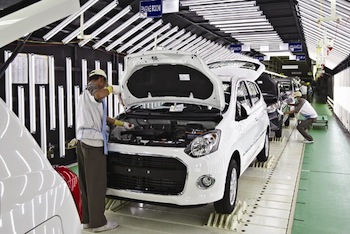
Pushing on regardless
These difficulties do not stop non-Japanese makers trying to crack the region, which, combining all the South-East Asian countries that comprise ASEAN, is the fifth-largest vehicle market in the world and the one with arguably the biggest potential, given the low rate of car ownership (below 100 per 1,000 in Indonesia).
VW is another OEM which has signed up to Thailand’s Eco Car 2 scheme – while rumours continue that it is also planning an Indonesian plant. Thongpak thinks that coming in cold with a locally made small car by 2019 would be too ambitious for the brand, and advocates a soft lead-up via a CKD operation and dealer expansion.
Another European manufacturer that could be planning a big push into the region is PSA Peugeot Citroen, which is planning production with its Chinese joint venture partner, Dongfeng. The alliance will make Peugeot cars with the Thaco Group in Vietnam and has already started production in Malaysia with the Naza Group, Reuters reported back in May. Peugeot is not exactly lighting up the sales charts in Vietnam at the moment, selling just 138 cars in the first four months to the end of April, according to the local manufacturers’ association, VAMA, but right now the country is one of the few in the region showing growth. In the first four months of this year, Vietnam’s vehicle sales rose an impressive 62% to just under 67,000, with cars up 54% and CVs increasing 75% to record 25,468.
Vietnam is one of the more diverse markets in terms of brands and represents an opportunity for the non-Japanese manufacturers. For example Ford, which has a factory there, has a 10% market share in the country, with the Transit 16-seat minibus its bestseller overall and the EcoSport small SUV its bestselling car in the first four months. Occupying the number-one spot over the same period is the Thaco-built Kia K3000 van. IHS expects Vietnam to build over 100,000 cars and CVs this year – the first time it will have done so.
Chinese brands eager to expand
Dongfeng is not the first Chinese maker to look at South-East Asia as a manufacturing base to grow sales in the region. China’s giant SAIC automotive group has already built a factory to make its MG brand in Thailand. The first, the D-segment MG6, rolled off the production line last year and the B-segment MG3 started this year, both in right-hand drive. The company has also signed up to the Eco Car 2 scheme, but Thongpak believes it needs to boost its local content before it can reap those benefits, which include a 14% excise tax compared with 30-50% for regular cars. It also had a slow start last year, selling just 200 MG6s.
SAIC is eyeing up other counties in the region. In May, Malaysian newspaper The Star reported that the company had bought a 49% stake in a local vehicle distributor, Weststar Maxus, with a view to establishing an assembly plant in the country. WestStar already builds SAIC’s Maxus light CV, a van that started life in Britain as an LDV, and commentators there said the new deal could bring CKD MG production to Malaysia.
The country would be a tough one to crack in terms of sales. The market is dominated by two local makers: Proton and the Daihatsu joint venture, Perodua, which together took almost half the 668,479-unit market in 2014. The next three brands were, unsurprisingly, Toyota, Honda and Nissan. However, the Chinese are persisting both there and elsewhere in the region. CV-maker Beiqi Foton – famous for its Daimler joint venture in China to make Auman-branded trucks – was reported by Reuters in May as planning a manufacturing subsidiary in Thailand, possibly to make pick-ups. It is also supposedly planning a factory in Indonesia to make Auman heavy trucks, although the company has a history of failing to deliver on plant promises outside China, most notably in India.
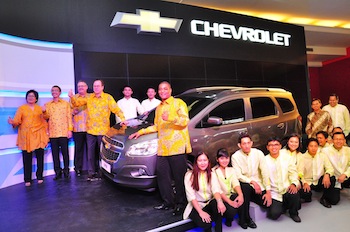
Ironically, this brings GM back into the country just as it has admitted the failure of its locally produced Chevy cars, but the Wuling-branded vehicles are arguably a better fit in the country and will take on the similar Daihatsu Gran Max range, the fourth bestseller in the country in 2014. Wuling said the vehicles will be sold primarily in Indonesia, with the potential for exports to other ASEAN markets in the future. A source at the company told Reuters it was uninterested in taking over GM’s shuttered Bekasi plant.
Key opportunities for makers
The predominantly MPV market in Indonesia has recently been given a push by the government’s Low Cost Green Car programme, which, like the Thai scheme, offers incentives for makers to produce economical small cars with high local content. Last year, 172,120 were sold in the country, compared with 51,180 in 2013. The most popular model was the Toyota Agya, built in Daihatsu’s Jakarta factory alongside the Daihatsu Ayla, while others include Datsun’s Go and seven-seat Go+.
"[Honda's HR-V small SUV is] one of the few model models that is not declining in the Thai market" – Jessada Thongpak, IHS
Another booming niche is the B-segment SUV, and one that could offer a toehold to non-Japanese companies. “It’s a new trend across the whole of SE Asia for SUVs,” states Thongpak. Popular models in Indonesia include the Toyota Rush, based on and built in the same factory as the Daihatsu Terios. The Rush had moved into fifth place by the end of April. In Thailand, Honda is doing well with its HR-V small SUV, which started production in the country late last year. “It’s one of the few model models that is not declining in the Thai market,” says Thongpak. It is also performing highly in Indonesia, reaching seventh in the chart for April.
Also expected in the market in the medium term is a new small SUV from Nissan, which has struggled to sell its more European-orientated Juke in the region. Furthermore, MG is also thinking of using this segment to better establish itself locally, according to Thongpak. Ford is struggling with sales of its locally built EcoSport in Thailand but, as noted above, it is the OEM’s bestselling car in the healthy market of Vietnam.

A potential big change in the future is the planned liberalisation of markets via the Trans-Pacific Partnership (TPP), a free-trade association that aims to draw in countries around the Pacific, including the US, Australia, Malaysia, Mexico and Vietnam. Opening up markets for American cars is one key aim; a statement on the American Automotive Policy Council website said that “several of the TPP countries included in the talks have markets closed to US auto exports. Obtaining access to these growing auto markets, such as Malaysia and Vietnam, is essential to maintaining and expanding America’s already robust auto exports”.
Daihatsu and its partner Perodua are already planning for this eventuality. The Japanese maker said as much in its 2014 financial report, stating: “We must keep a close watch on the trend toward membership in the Trans-Pacific Partnership. If Malaysia joins the TPP, the competitive environment will further intensify with the liberalisation of the automotive market.” It promised further cost reduction and “reinforcement management structure” to keep its cars competitive. Malaysia’s manufacturers enjoy significant tax benefits that have so far protected its home-grown automotive industry.
Malaysia has also launched its own version of Thailand and Indonesia’s Eco Car schemes to attract makers, but given that this depends on generous tax incentives, the TPP might scupper it. Even without the TPP, Thongpak at IHS believes the medium-term plan to build 200,000 cars is ambitious. “The OEMs’ strategy is very strong in Thailand and Indonesia. Given Malaysia is targeting to build the same thing, that’s not likely to happen mid-term.” Thongpak says 50,000 vehicles were built last year under this scheme.
Meanwhile, Vietnam is reportedly already planning to liberalise its market by cutting car import tax to zero by 2018, opening it up to non-localised brands. In May, the president of VAMA, Yoshihisa Maruta, who is also the head of Toyota Motor Vietnam, told Vietnam News that cutting the tax would affect domestic car production, and called for local protection.
South-East Asia’s huge motorcycle market is also in flux at the moment. Thailand’s domestic motorcycle market fell 19% to the end of April, although it was still up 4% on the year at just over 585,000 units. Production might have fallen except for the fact that exports have soared 19% in the first four months to 340,213. With that, production was up 5% to 670,037. Thailand is fast becoming a hub for premium bike-makers, with both the UK’s Triumph brand and VW-owned Ducati building machines for export there.
Vietnam has also seen sales stall, clocking 2.9m last year, only slightly up on 2013’s figure of 2.8m, according to the local makers’ association, VAMM. Honda last November opened its third manufacturing site in the country, just south of Hanoi. The plant has a capacity of 500,000 units, mostly scooters. The company said it had a market share of 70% in Vietnam in 2014.
The region’s biggest bike-maker, Indonesia, is also suffering. In the first four months, production of motorcycles fell 18% to 2.2m, according to the Indonesian Motorcycle Industry Association (AISI). Honda’s local production slipped 12% to 1.5m, accounting for 67% of all motorcycles made in Indonesia this year. Production for second-placed Yamaha slipped 25%, while Suzuki saw a massive drop of 77%.

Non-Japanese makers are trying to break the Japanese hold on bikes, too; Italian company Piaggio makes in Vietnam while Benelli, also Italian but recently revived by the Chinese, has started selling in Indonesia. Their struggle is no less severe than that of the Japanese carmakers, but the fact they are persisting indicates the importance and potential of this region.





























